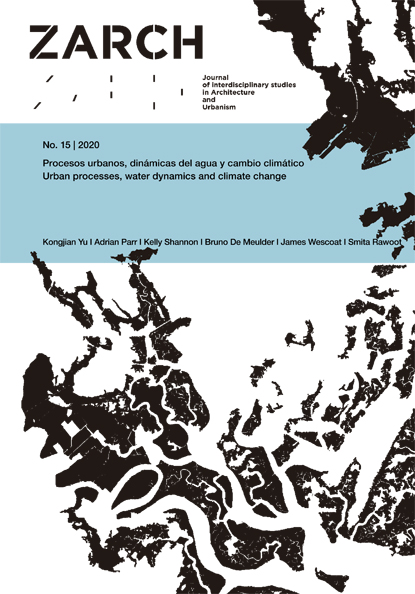CDMX Resilient Code: Water Commons in Mexico City
DOI:
https://doi.org/10.26754/ojs_zarch/zarch.2020154492Keywords:
Water Imaginary, Equitable Resilience, Resilient Code, Soft-Bottom Up Infrastructure, Water Commons, Hydro-Social Risk ReductionAbstract
Using Mexico City (CDMX) as a paradigmatic example of seriously unbalanced water regimes, our project Resilient Code helps strengthen and communicate CDMX’s government efforts toward risk reduction and water resilience in marginal communities. Our project does so by bridging otherwise separate agents in the government towards a common goal: equitable resilience. Resilient Code provides design solutions that link the social infrastructure of PILARES (a network of 300 vocational schools distributed throughout the city) to CDMX’s environmental and risk reduction initiatives, including their Risk Atlas. This strategic program of design-based solutions began with “water resilience” as a Pilot to repurpose public space throughout underserviced barrios as a network of “water-commons”. Resilient Code helps partners in CDMX implement projects to reduce environmental risks and complement socio-economic programs, fostering growth of the “water-commons”. Resilient Code is socialized through a participatory game-based workshop, and through an online Atlas of Risk Reduction.
Downloads
References
Agencia Digital de Innovación Pública, (ADIP), CDMX City Council, https://adip.cdmx.gob.mx/
Aquatech. 2019. Mexico City mayor pledges water for all by 2024. (June 18th). https://www.aquatechtrade.com/news/urban-water/mexico-city-mayor-pledges-water-for-all-by-2024/ (Accessed May 31st , 2020).
Ahlers, R.; Cleaver, F.; Rusca, M. and Schwartz, K. 2014. Informal space in the urban waterscape: Disaggregation and co-production of water services. Water Alternatives. 7(1): 1-14.
Bello Gómez, Lorena. 2020. Swampification. Swamps and the New Imagination. Cambridge: MIT Press
Bello Gómez, Lorena; Williams, Sarah. 2019. Resilient Code: Mexico City (CDMX) A proactive toolkit to foster equitable resilience. MIT School of Architecture and Planning: Fall Practicum.
Bello Gómez, Lorena; Samper, Jota. 2015. Providing infrastructure for informal settlements in Medellin, Colombia. MIT School of Architecture and Planning: Spring Semester.
Castillo, Jose. 2010. The promise of Neza: Building a city of 1.2 million inhabitants one house at a time. Re-Inventing Construction, Ilka & Andreas Ruby eds., 388-403. Zurich: Ruby Press.
Davis, Diane; Castillo, Jose. 2016. The flexible Leviathan: Reconsidering scale and fixity in Iztapalapa, Mexico City. Cambridge, Massachusetts: Harvard University Graduate School of Design.
Davis, Diane. 2015. From risk to resilience and back: New design assemblages for confronting unknown future. Topos, Garten + Landschaft, (June): 57-59.
Deltares, Urbanisten et al. 2016. Towards a water sensitive Mexico City. Mexico City: Autoridad de Espacio Público. https://www.deltares.nl/app/uploads/2018/01/20160629_WS-CDMX_final-version-report-smsize.pdf
Echeverri, A., & Orsini, F. M. 2011. Informalidad y urbanismo social en Medellín. Sostenible?, (12), 11-24.
Fairchild Ruggles, Dede. 2019. Water and community in Islamic Granada. MIT: AKPIA Fall Lecture.
Latouche, Serge. 2009. Farewell to Growth. Polity.
Latour, Bruno. 2018. Down to earth: Politics in the new climatic regime (English ed.). Cambridge, UK; Medford, MA: Polity Press.
Legorreta, Jorge. 2009. Ríos, Lagos y Manantiales del Valle de México. México: Universidad Autónoma Metropolitana-Atzapozalco.
_____. 2006. El Agua y la Ciudad de México. De Tenochtitlan a la Megalópolis del Siglo XXI. Ciudad de México: Universidad Autónoma Metropolitana-Azcapotzalco.
_____. 1997. Agua de lluvia, la llave del futuro en el valle de México. La Jornada Ecológica, año 5, número 58: 1-12.
Lindsey J. Butler, Madeleine K. Scammell, and Eugene B. Benson. 2016. The Flint, Mitchigan, water crisis. Environmental Justice. (Aug 2016): 93-97.
Madrid, Gustavo. 2016. Plan hídrico: Estudio hidrológico en la Delegación Miguel Hidalgo. Mexico City: Miguel Hidalgo.
McHarg, Ian L. 1992. Design with Nature. 25th Anniversary ed. New York: J. Wiley.
Naafs, Saskia. 2014. Amsterdam Rainproof: Every Drop Counts. Amsterdam: Waternet. https://www.rainproof.nl/sites/default/files/rainproof-magazine-engels.pdf (accessed May 25th, 2020)
Perlo, Manuel; Castro Reguera, Loreta. 2018. La crisis del agua y la Metropolis. México: Grupo Siglo XXI.
PILARES, Secretary of Education. Mexico City: CDMX City Council. https://pilares.cdmx.gob.mx/
Rama, Angel. 1984. La Ciudad Letrada, Serie Rama. U.S.A.: Ediciones del Norte.
Rinne, Katherine Wentworth. 2010. The Waters of Rome: Aqueducts, Fountains, and the Birth of the Baroque City. 1st ed. New Haven: Yale University Press.
Rockefeller Foundation. 2013. 100 Resilient Cities Initiative, https://www.100resilientcities.org/cities/mexico-city/ (accessed May 28th 2020).
CDMX Resilience Office. CDMX Resilience Strategy. Adaptive, inclusive and equitable transformation. Mexico City: Resilience Office 100 Resilient Cities, (2016), http://100resilientcities.org/wp-content/uploads/2017/07/CDMX-Resilience-Strategy-English_2.pdf
Rubert de Ventós, Maria. 2020. La calle postcovid: la mitad de asfalto, el doble de árboles y más transporte público. El Periodico. May 25th, opinión.
SEDEMA. 2019. Rain harvesting program. Mexico City: CDMX City Council. https://sedema.cdmx.gob.mx/programas/programa/programa-de-sistemas-de-captacion-de-agua-de-lluvia-en-viviendas-de-la-ciudad-de-mexico
SEDEMA. 2016. Climate Action Program. Progress Report. Climate Change and Clean Development Mechanisms Projects Teams. México City: CDMX City Council. https://sedema.cdmx.gob.mx/storage/app/media/programas/cambio-climatico/ELACCM-2014-2020-completo.pdf
SEDEMA. 2014. Climate Action Program. México City: CDMX City Council. http://www.cms.sedema.cdmx.gob.mx/storage/app/media/PACCM-2014-2020.pdf
Sistema de Aguas de la Ciudad de México (SACMEX). Plan Integral de Agua 2012. Mexico City: CDMX City Council. http://www.agua.unam.mx/sacmex/assets/docs/PGIRH_Final.pdf
Sistema de Aguas de la Ciudad de México (SACMEX). Plan Agua 2014. Mexico City: CDMX City Council.https://www.cmic.org.mx/comisiones/Sectoriales/infraestructurahidraulica/Plan_Agua_para_el_Futuro/PLAN%20AGUA%20PARA%20EL%20FUTURO%20CDMX-01abr-14.pdf
Solà-Morales i Rubió, Manuel De. 2008. A Matter of Things. Rotterdam: NAI.
_____. 2005. Four paradigms of a course in the ethics of urbanism. The Territories of the Urbanist, coords. Antonio Font, Miquel Corominas, Joaquín Sabaté, 63-69. Barcelona: Fundació Politècnica de Catalunya.
Soria i Puig, Arturo. 1995. Ildefonso Cerdá's General Theory of 'Urbanización'. The Town Planning Review, Vol. 66, No. 1 (Jan., 1995): 37. Liverpool University Press.
Spirn, Anne Whiston. 1996. Constructing nature: the legacy of Frederick Law Olmsted. Uncommon ground: Rethinking the human place in nature, 91-113.
_____. 1988. The poetics of city and nature: Towards a new aesthetic for urban design. Landscape Journal, 7(2): 108-126.
Vale, Larr. J. 2014. The politics of resilient cities: whose resilience and whose city?. Building Research & Information, 42(2), 191-201.
Velasco, Guillermo et al. 2014. Local strategy for climate action. CDMX: Centro Mario Molina para estudios estratégicos. https://sedema.cdmx.gob.mx/storage/app/media/programas/cambio-climatico/ELACCM-2014-2020-completo.pdf (accessed May 28th 2020)
Voytenko, Y., McCormick, K., Evans, J., & Schwila, G. 2016. Urban living labs for sustainability and low carbon cities in Europe: Towards a research agenda. Journal of Cleaner Production, (June):45–54.


